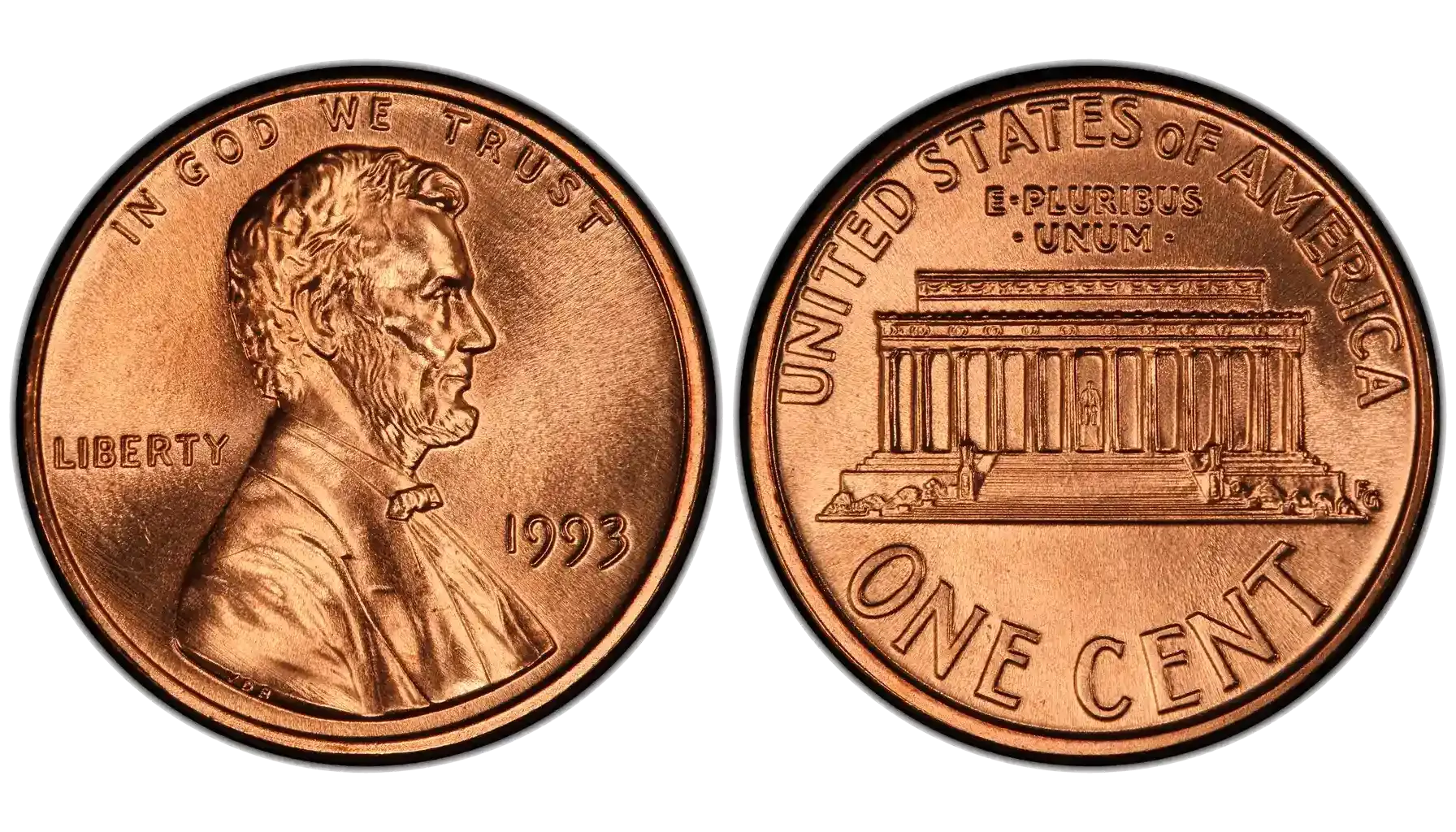Contents:
- State Quarters Design
- State Quarters Overview
- History Of The State Quarters
- The Value of Gold Quarter
- Gold Proof VS Gold Plated Quarters
- Real Gold Quarter Example
- Quarter Grading
- Gold Quarter Errors
- Rim Error
- Extra Parts Error
- Die Crack Error
- Gold Plated Quarters Value
- The Most Valuable Plated Quarters
- Gold VS Plated Identification Guide
- Coin ID Scanner
- FAQ and Answers
Commonly, the face value of a quarter is… well, 25 cents. Yet with a precious material, the value is much higher.
How much are gold quarters worth? How can you identify them? The answers are right here.
Online Coin Identifier can also tell what kind of coin is in your collection!
State Quarters Design
These quarters constantly changed their designs throughout the 1999-2008 series.
The first release in 1999 had different reverse designs depending on the city it meant to commemorate.

Delaware. Features Caesar Rodney on horseback.
Pennsylvania. Shows the Commonwealth statue, a keystone (symbol of the state), and an outline of Pennsylvania.
New Jersey. Depicts Washington Crossing the Delaware River, based on the famous painting.
Georgia. Features a peach (state fruit), live oak sprigs (state tree), and the state outline.
Connecticut. Shows the Charter Oak tree.
Unlike the reverse, all these coins share the same observe.
The observe features the portrait of George Washington, the first President of the United States. The motto "IN GOD WE TRUST" is on his right. The lettering "LIBERTY" is on the left. The lettering "UNITED STATES OF AMERICA” arches over the President from above, and “QUARTER DOLLAR” from below.
State Quarters Overview
The main characteristics of the Gold Quarters 1999 | |
Country | United States |
Years of Minting | 1999 |
Type: | Commemorative coin |
Edge | Reeded |
Shape: | Round |
Composition and metal content | Manganese brass-clad copper |
Weight | 8.1 grams |
The Mints | The Philadelphia Mint, The Denver Mint |
Fun fact: Your gold quarter is not the first version. The series was first released in silver. The 50 states commemorative quarters Gold Edition appeared a bit later.
History Of The State Quarters
In 1999, the United States Mint started a series of circulating commemorative quarters. They featured unique designs for each of the 50 US states on the reverse.
Soon, the series became exceptionally successful. Numismatists were collecting them across the US.
Gold quarters 2000 were an exceptionally big release, with every city-coin having more than a billion mintage.
After featuring all 50 states in 2008, the series ended.
The Value of Gold Quarter
What are gold quarters worth? The value depends on several factors, like:
Mintage. Lower mintage equals more value. For example, the smaller 2002 commemorative quarters Gold Edition is usually a bit pricier than the 2000 release.
High-grade releases. Non-plated, uncirculated coins in perfect condition are more valuable.
Precious metal releases. 24k gold plated state quarters worth is higher than simple copper releases.
Error releases. Flawed coins are rarer and therefore more valuable.
Gold quarters worth money should fit into one of these categories
Gold Proof VS Gold Plated Quarters
Are gold quarters real? Yes, technically, but not all of them are made equal.
Gold pieces are composed of this precious metal almost entirely. The golden-plated versions only have a layer of gold splashed on top. Some even mockingly call them gold colored quarters.
Here’s a little overview of their differences.
Characteristic | Plated | Whole-gold |
Metal composition | 75% copper, 25% nickel. The core is pure copper. 24k gold layer. | 99.99% pure gold |
Circulation | Circulated | Non-circulated |
Finish | Shiny | Somewhat dull |
Weight | Light | Heavy (8+ grams) |
Collectible value | Medium-low | High |
The 50 State Series is gold-plated quarters. It’s not a bad sign entirely. Some of them could be sold for a very high value. Some people call them “gold quarters” anyway, even if they’re not entirely gold.
Real Gold Quarter Example
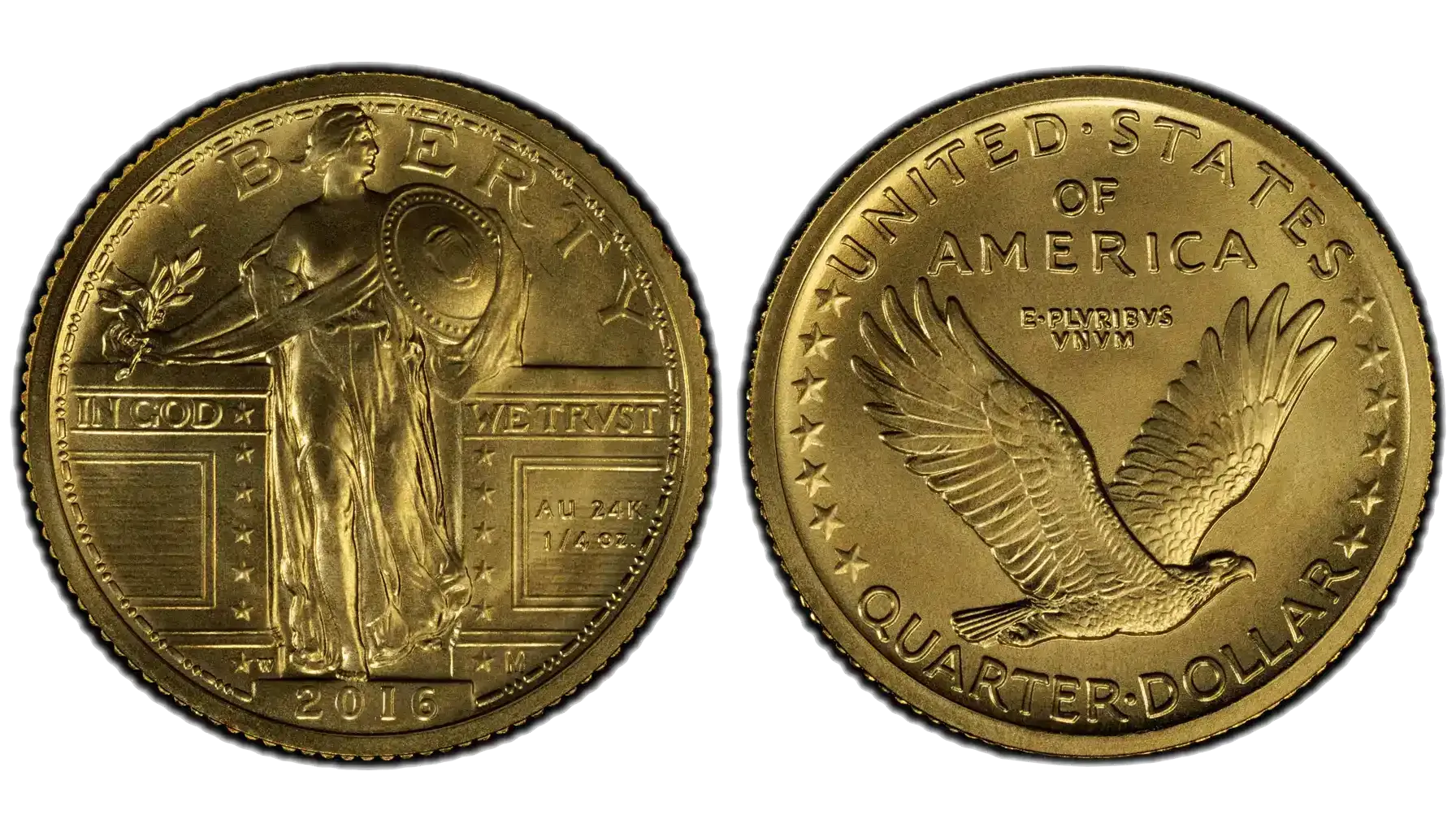
Only one sanctioned golden quarter was released in the US, the 2016-W Standing Liberty Quarter. Each coin contains one-fourth ounce of pure 24 karat gold.
While its face value is 25 cents, it’s 99% gold. The U.S. Mint. made about 91.700 Standing Liberty quarters, which makes its value even higher.
This quarter’s value is more than $500.
Quarter Grading
Since metal-wise these quarters are not in luck, maybe grading could increase their value.
Quarter grading depends on the coin’s state. The way its details and original shine are preserved.
Grade | Name | Description |
P-1 to G-4 | Poor to Good | Very worn, details barely visible |
VG-8 to F-12 | Very Good to Fine | Heavy wear, some design visible |
VF-20 to EF-40 | Very Fine to Extremely Fine | Moderate wear, main details intact |
AU-50 to AU-58 | About Uncirculated | Minor signs of wear, almost uncirculated |
MS-60 to MS-70 | Mint State (Uncirculated) | No wear at all; MS-70 is perfect |
Are gold quarters worth anything? With mint-state quality, definitely.
Gold Quarter Errors
One more value-increasing factor is the presence of errors.
Silver quarter releases were more circulated and had more varied errors. Silver 2004 Wisconsin Quarter was especially popular for its errors.
Still, golden releases had their share of errors.
Rim Error
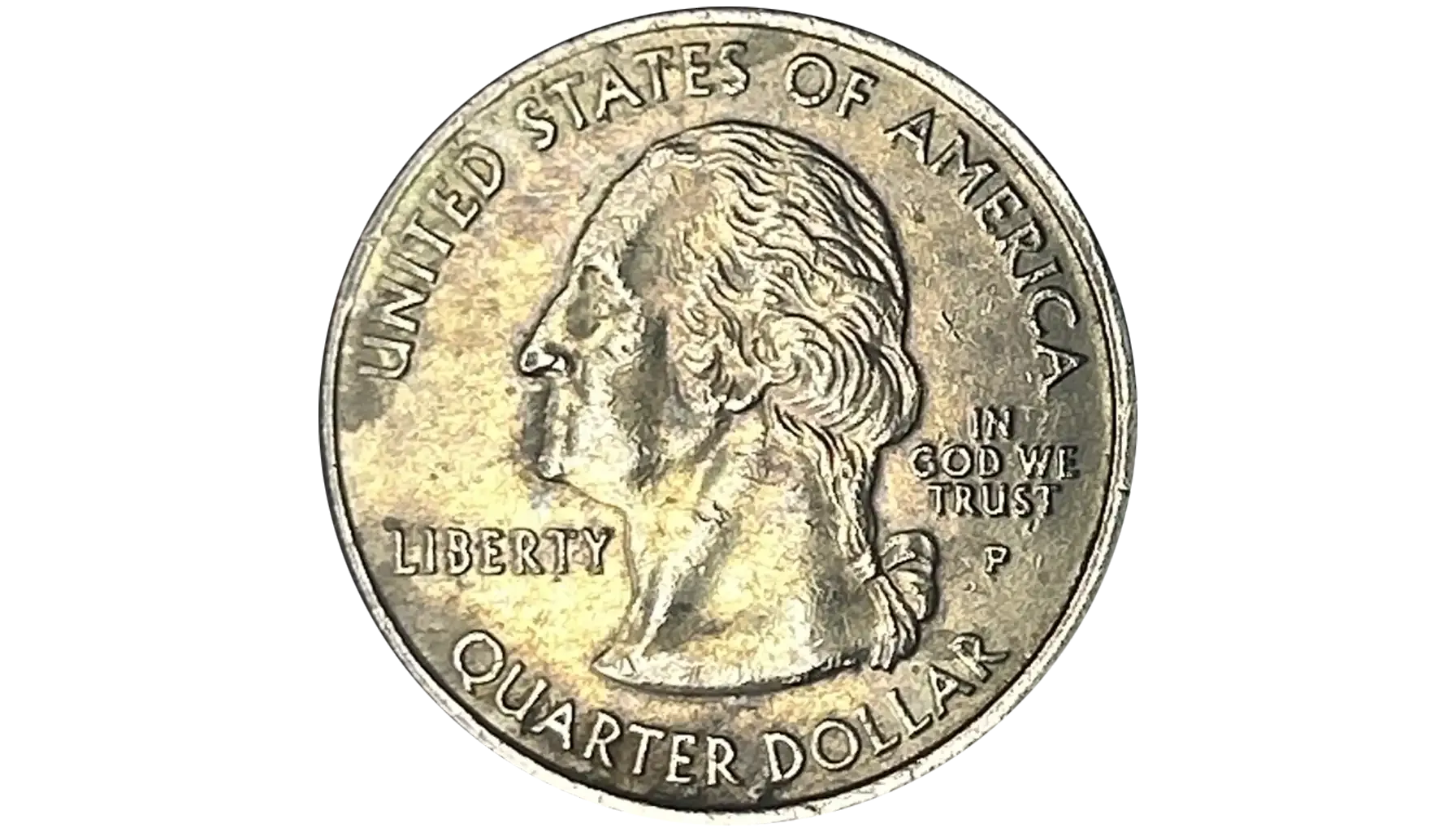
Look for: Uneven rim, wider or thinner at some places. Sometimes the edge is even missing.
Value: $50 and more.
Error cause: The coin was struck unevenly by the press.
Extra Parts Error
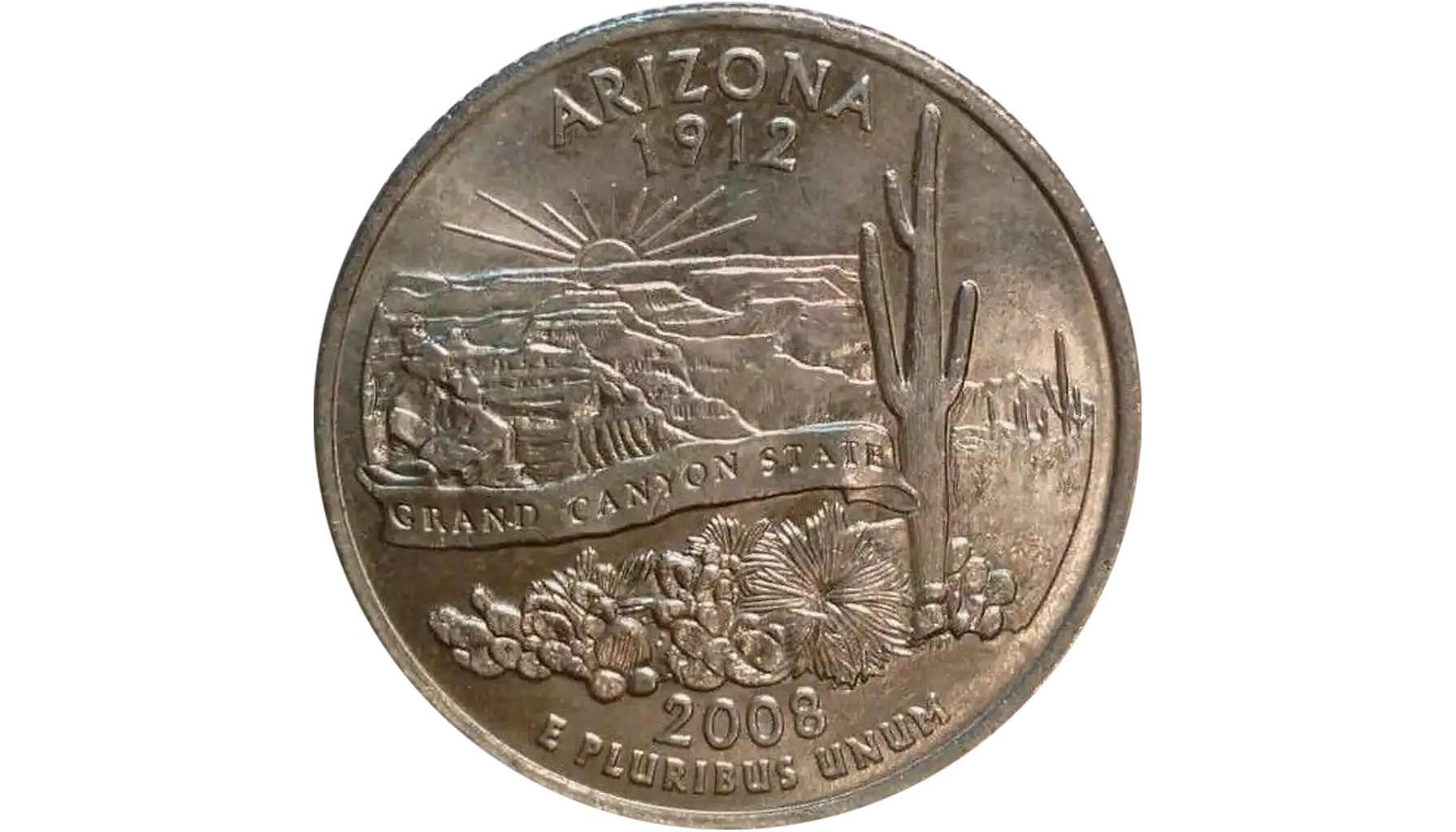
Look for: Extra parts appearing on the surface. In this case, the coin has an extra cactus leaf.
Value: $70 and more.
Error cause: When the coin was struck, some previous parts were left imprinted.
Die Crack Error
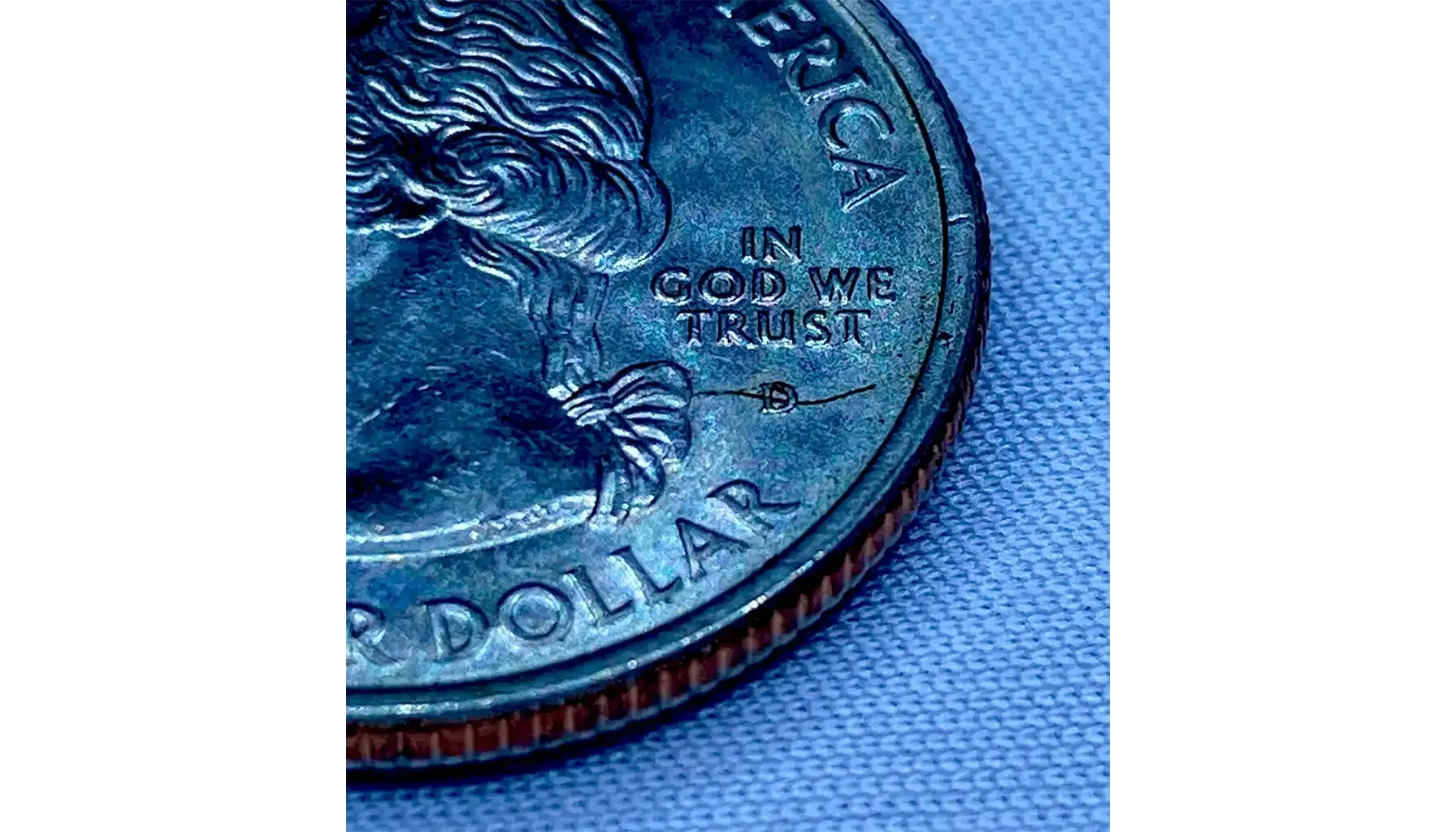
Look for: Cracks appearing on the coin’s surface. Some parts of the piece might look elevated due to the drift.
Value: $15 and more, depending on the crack’s severity.
Error cause: The die, used to strike the coin, developed a fracture during the minting process.
Gold Plated Quarters Value
You might expect a big price difference. With so many releases throughout 1999-2008, and with 50 different designs. While it’s true for the silver releases, the Golden Editions are more unified.
How much are gold plated quarters worth? Their value is $1-$5.
The reasons for this value are:
The Gold layer is extremely thin. Less than a cent’s worth of actual gold.
Alteration. Since the plating is added after minting, these coins are not legal U.S. Mint products in their golden form. Collectors typically want original, unaltered coins.
Mass-production. Golden-plated pieces were heavily marketed via TV, magazines, and the Internet in the 2000s. Too many pieces, too low value.
The Most Valuable Plated Quarters
Gold State quarters value could be much higher in special cases. Here are some of the known examples:
Quarter | Value Cause | Max Known Sale |
1999 Georgia Test Planchet | Experimental strike | $10,000+ |
2004-D Wisconsin Extra Leaf | Mint error | $6,000+ |
2001-P NY Wrong Planchet | Wrong metal + error | $3,000+ |
2000-P SC Off-Center | Strike error | $2,500+ |
MS-69 State Quarters | Near-perfect condition | $1,000–$2,000+ |
All of these “champions” have either an exceptional quality or exceptional errors. All of them are rare gold quarters.
Gold VS Plated Identification Guide
A little farewell gift. A guide to help you see if a piece is gold or just plated.
1. Check the official Info and package.
In the 50 State Series Case, the Mints never officially minted solid-gold pieces.
For other coins, check the package. A plated coin has “layered,” “24k plated,” or “tribute” marks on the package,
2. Use a Magnet.
Real gold is not magnetic. If your piece is magnetic, it’s probably steel-based.
3. Check the Weight.
Gold is heavy! A real 24k quarter weighs ~8,33 grams. A standard 50 State Quarter weighs about 5,5 grams.
4. Visual Inspection. Look for:
Worn areas revealing silver or copper underneath (plated).
Mirror finish & fine detail (may indicate proof or commemorative coins).
Inconsistent color with golden-coloured patches (plated).
6. Get It Professionally Tested. If unsure, why not ask the specialist?
A coin dealer or a jeweler (they may have XRF testers).
Grading services (like PCGS/NGC) for authentication.

Coin ID Scanner
Coin ID Scanner is a free app for numismatists.
Take a photo, and the AI-driven recognition will help identify your coin.
The app has a vast database. You can identify and learn about a lot of coins, including 50 US State Quarters series.
There are also many fun and helpful Blogs about collecting and trading. If you have some other questions about coins, the AI-assistant will always be ready to help.
FAQ and Answers
Some minor questions are here.
Why are Some Quarters Gold?
Some quarters appear golden because they are either struck from this metal, or because of natural toning or artificial treatment (plated).
Why Are There Gold Quarters?
Some pieces are struck in this metal to increase their value and beauty.
Are Gold Quarters Rare?
Genuine golden quarters are definitely rare. There are only a few examples of such coins, like 2016 Standing Liberty. The plated pieces, on the other hand, are common enough.
How Many Gold Quarters Were Made?
In the US, there’s only one official “real” gold quarter, 2016-W Standing Liberty Quarter. Only about 91,700 of these quarters were ever made. All in the West Point Mint, the producer known for its limited premium releases.

